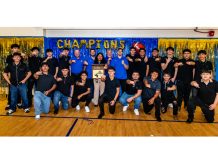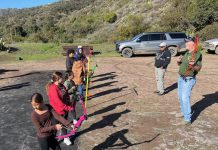An ensemble of the Stanford Symphony Orchestra will be featured in the Catalina Island Museum’s first Holiday Concert on Dec. 13 in the Avalon Casino Theatre. Thanks to the museum’s members and sponsors, this concert is being offered at no charge.
An ensemble of the Stanford Symphony Orchestra will be featured in the Catalina Island Museum’s first Holiday Concert on Dec. 13 in the Avalon Casino Theatre. Thanks to the museum’s members and sponsors, this concert is being offered at no charge.
Assistant Conductor of the Stanford University Orchestral Studies Program, Anna Wittstruck, will be director of the 13-member ensemble comprised of Stanford University undergraduates, graduate students and community players. Ms. Wittstruck recently spoke with the Catalina Island Museum during a brief interview.
At what age were you introduced to symphony orchestra?
I began playing cello in the local youth symphony in sixth grade. This was my first hands-on experience in a symphony orchestra. I must have heard an orchestra perform before that, but orchestra was not a meaningful part of my life until I started participating in it.
At one point you were the youngest contracted member of the Asheville Symphony Orchestra. Can you describe this experience?
I am from Asheville, North Carolina. It’s a fairly small city and I quickly advanced past the level of the local youth orchestra. When I was in eighth grade, there was an opening in the cello section of the Asheville Symphony – our professional orchestra. I had been studying with a Suzuki cello teacher named Frances Duff, but had started driving down to Atlanta, Georgia, for lessons with an acclaimed pedagogue.
I still met with Frances once a week (I danced with her daughter, so my lessons took place at the ballet studio) and for that entire year she helped me prepare the music to audition for the Asheville Symphony. We drilled that audition music – a concerto and standard orchestral excerpts – over and over again for months. The audition was blind; no one on the other side of the screen knew how old I was.
I was 14 years old at the time. That spring, after my audition, they offered me a contract, and I played with the symphony all four years of high school. When the personnel manager called me to congratulate me on winning the position, she jokingly asked if the evening rehearsal schedule would go past my bedtime.
It was like learning how to swim by being thrown into the deep end of a pool; everyone had more experience than me, but I learned from them. I discovered how to be part of an ensemble, how to follow a conductor, and how to learn the notes quickly. Professional orchestras have very few rehearsals before each concert, and I learned a tremendous amount of repertoire through this experience.
There may be some individuals in our audience that have never experienced a live symphony orchestra. Can you briefly describe what they can expect to see and hear?
This concert program features a small sub-set of our symphony orchestra. You won’t experience the raw power of a hundred people playing on stage together, of rumbling percussion and brassy fanfares. Instead, this will be a very intimate performance experience – almost like chamber music. The audience will have a good sense of each musician’s individual personality and sound, and how that sound blends between string players and woodwind players.
We are showcasing different groups of instruments: from solo piano to a string quartet to the thirteen-person mix of strings and woodwinds needed to perform Aaron Copland’s beloved Appalachian Spring. There is something visceral and exciting about experiencing live classical music that cannot be replicated; it’s a real joy to present that to people for the first time.
What is your role as the conductor?
All of the musicians on stage have strong feelings about how the music should go. What is essential for a good ensemble is to have a unified feeling about the music. This is where the conductor becomes important. I study the score, try to honor what the composer says about how fast the music should be, how loud it is, what kind of mood it has, how it is phrased, etc, and then – having conceived of a clear interpretation – show with my baton how the music will flow.
With a piece like Appalachian Spring, the meter is always changing, and so just keeping time for the musicians and showing them the downbeats for each measure is quite important.
The tempo and affect are also constantly changing; for these transitions, I serve as a guide. What is most important is for the players to feel confident about what they are doing, and to always know what is going to happen next. My baton shows them where the music is going next and they respond to it together.
What type of process do you go through when developing a program for an event like this?
For programming this kind of event, we start with the question: how many musicians will be performing? Because it is a small ensemble for this performance, our Music Director, Jindong Cai, suggested Appalachian Spring. It’s a beautiful piece of music, important repertoire for the players and me to learn, and it embodies a sound-world – nature, folk tunes – that people really identify with.
Aaron Copland is possibly one of the most “American” sounding composers and Appalachian Spring is a perfect example of America described through music, from the serenity of the open, expansive intervals in the Introduction, to the “Simple Gifts” tune at the end.
I therefore wanted to craft a program around the idea of American music, as well as a program that would showcase our fantastic players.
We begin with the Dvorak “American” Quartet. Dvorak of course was Czech, but he came to the United States in the 19th century and is really the first composer to define a quintessentially American sound by integrating provincial folk songs into his art music.
We will also play music from his string serenade, which features the entire string section and also the glowing, pastoral sound of Dvorak’s compositions. Our pianist will then play the 3 Preludes by George Gershwin.
Gershwin was another great American composer and brings in a new dimension to this idea of American music: jazz.
Finally, we end with Appalachian Spring: contemplative, expansive, joyous. Appalachian Spring is thirty minutes of uninterrupted music, so I wanted to balance it out with pieces that are shorter, very fun and accessible, and showcase different combinations of instruments, while still tying together an overarching theme: “Sounds of America.”
The Holiday Concert, A Classical Christmas, will begin at 7 p.m. on Dec. 13 in the Avalon Casino Theatre. Tickets are available at the Catalina Island Museum. Tickets may also be requested by phone at 310-510-2414 or by visiting the events page at www.CatalinaMuseum.org. Doors will open at 6:30 p.m. Seating is limited and tickets are required. Limit 5 tickets per person.
Prior to the Holiday Concert, visit the Catalina Island Museum’s annual Holiday Open House from 4 p.m. to 7 p.m.
Attendees will enjoy free admission to the museum and its special exhibition, Avalon: 100 Years of Bizarre, Fascinating and Colorful History, 10% – 50% off every item in the Museum Store and a free tasting by Steve’s Steakhouse.
During this event members of the museum will receive their normal 15% discount on top of the already reduced prices throughout the museum’s store.
The Catalina Island Museum is Avalon’s sole institution devoted to art, culture and history.
The museum, its digital theater and store are located on the ground floor of Avalon’s historic Casino and are open 7 days a week, from 10 a.m. to 5 p.m.
For more information, the museum may be reached by phone at 310-510-2414 or at its website: CatalinaMuseum.org.










